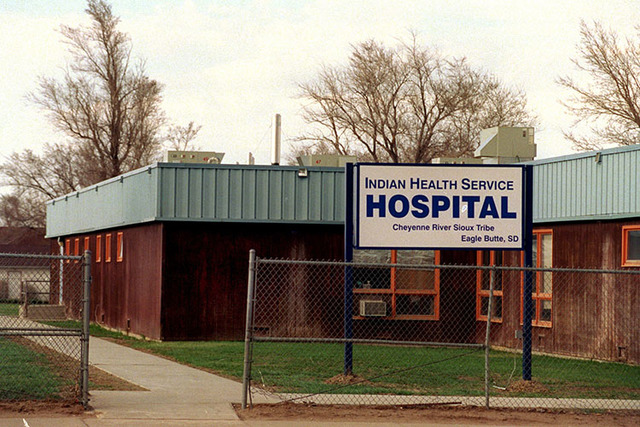Study: Conditions at American Indian hospitals deplorable
WASHINGTON — After killing much of the native population, then assigning survivors to desolate reservations, the U.S. government established a range of programs to serve American Indians.
Now, a new report demonstrates government health care is another way they are disregarded.
The study by the Department of Health and Human Services’ internal watchdog describes Indian Health Service hospitals lacking operating rooms, sophisticated equipment and sufficient staffing. IHS also serves Alaska Natives.
Many of the 28 IHS hospitals are small, with fewer than 50 beds. Another 18 hospitals operate under contract. While some facilities admit few inpatients on a daily basis, the number of outpatients increased 70 percent from 1986 to 2013 and exceed the hospitals’ capabilities. This results in long waiting times and difficulty in scheduling appointments, according to the Office of Inspector General’s (IG) report on “longstanding challenges.”
Yet, despite the outpatient escalation, “most IHS hospitals have exceedingly low numbers of patients admitted to inpatient wards,” leading to depressed staff recruitment, retention and quality of care, the report said. The physician vacancy rate for IHS hospitals was 33 percent in 2014; nationally it was 18 percent in 2013.
“Right now the government is doing a terrible job of providing health care for Native Americans,” said Brian Cladoosby, president of the National Congress of American Indians and chairman of the Swinomish tribe in Washington state.
Patients can be referred to private facilities, but the budget for that is too small. In 2013, 147,000 referrals for private care were denied.
The IG report says that “many hospitals are in remote locations,” but that’s an understatement for those facilities 200 miles from the nearest city.
“One administrator reported that patients must travel 100-200 miles to receive post-acute care, which may be particularly problematic for patients at the end-of-life stage,” the report said. “Another hospital administrator described how the lack of resources (e.g., nursing homes, rehabilitation clinics) in the community and the ‘Third World’ living conditions (e.g., no running water or electricity) of many patients sometimes prevent the hospital from discharging patients, particularly during the winter months.”
IHS says it’s trying.
An agency statement said it “has been aggressive in its approach to address these challenges, working with tribal partners to implement a strategy that ensures a quality of care for its patients and instill a culture of accountability across the agency to improve health care delivery to its patients.”
The Obama administration’s fiscal year 2017 budget provides $6.6 billion for IHS, an increase of $402 million over 2016. The 2017 figure amounts to a 53 percent increase since 2008.
But with the current conditions, it’s no wonder that health statistics for the native population are so bad. Key IHS stats tell the tale — the infant mortality rate for American Indians/Alaska Natives is 26 percent higher than the general population’s, and their death rate is 26 percent higher than the white population. Native Americans and Alaskan Natives live five years less, on average, than white Americans.
An Indian Health Service report comparing Indian and Alaska Native death rates with the general population found these differences for specific causes:
- Alcohol related-520 percent greater
- Tuberculosis-450 percent greater
- Chronic liver disease and cirrhosis-368 percent greater
- Motor vehicle crashes-207 percent greater
- Diabetes mellitus-177 percent greater
- Unintentional injuries-141 percent greater
- Poisoning- 118 percent greater
- Homicide-86 percent greater
- Suicide-60 percent greater
- Pneumonia and influenza-37 percent greater
- Firearm injury-16 percent greater
Also in poor health are IHS hospitals. More than half are so old or inadequate that administrators said the facilities “challenged their ability to provide quality care.” For example, the report said “the aging structure in one IHS hospital caused sewage to leak into the operating room after its old pipes corroded.” It’s been 77 years since the agency’s two oldest hospitals had a major renovation.
The IG study and a companion report on the lack of quality care oversight “confirm what I’ve heard from folks in Indian country for years: IHS needs serious reforms,” Sen. Jon Tester, D-Mont., vice chairman of the Indian Affairs Committee, said by email. “Congress has a role to play by ensuring IHS has the resources it needs to provide care and recruit health care providers.”
HHS Secretary Sylvia Mathews Burwell was so concerned about the sorry state of IHS that she formed an executive council to marshal department-wide resources for assistance. The IG urged the executive council to “undertake a concerted effort to examine and address the longstanding challenges facing IHS hospitals.” The IG also told IHS that it needs a new strategic plan with action items and target dates to address the agency’s many problems.
“IHS concurs with the recommendations … and is committed to building on efforts currently underway to correct the service issues,” the agency statement said.

















